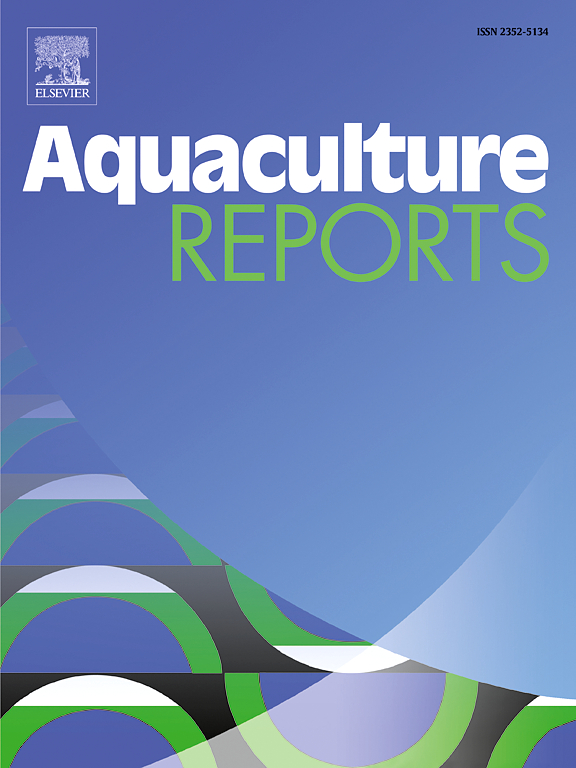Impact of kelp and fucoidan on lipid metabolism in large yellow croaker (Larimichthys crocea)
IF 3.2
2区 农林科学
Q1 FISHERIES
引用次数: 0
Abstract
To investigate the impact of kelp and its bioactive component fucoidan as feed additives on lipid metabolism in large yellow croaker (Larimichthys crocea), an 8-week feeding experiment was conducted using diets supplemented with 3 % kelp (Saccharina japonica, KM group) and 0.2 % fucoidan (FM group). Lipidomic analysis identified over 700 distinct lipids in the muscle, categorized into five main categories and 36 lipid subclasses. Among these, triglycerides (TGs) and phosphatidylcholines (PCs) were the predominant lipid components, with levels in the KM group reduced to 66.34–87.65 % of control values, along with a specific 1.75-fold increase in lysophosphatidylethanolamine (LPE 16:0). Besides, most fatty acids (FAs) demonstrated decreased content in the KM group, except for specific increases in α-linolenic acid (C18:3n-3), arachidonic acid (C20:4n-6), eicosenoic acid (C20:1n-9) and eicosapentaenoic acid (C20:5n-3). The FM group showed both up- and down-regulated trends in lipid content with only a few polyunsaturated fatty acids (PUFAs) showing a decrease. Notably, both kelp and fucoidan supplementation modulated cholesterol metabolism, reducing total and low-density lipoprotein (LDL) cholesterols while increasing high-density lipoprotein (HDL) cholesterol. Moreover, gene expression analysis further supported this finding, showing significant down-regulation of fas, lpl, and srebp1 (genes related to FA synthesis) in two groups, while up-regulation of aco, pparα, and pgc-1α (genes promoting β-oxidation) in the KM or FM groups. These results demonstrated that kelp and fucoidan could effectively alter the lipid composition, supporting their potential as sustainable feed additives in aquaculture.
海带和岩藻聚糖对大黄鱼脂质代谢的影响
为研究海带及其生物活性成分岩藻糖聚糖作为饲料添加剂对大黄鱼脂质代谢的影响,本试验采用在饲料中添加3 %海带(KM组)和0.2 %岩藻糖聚糖(FM组),为期8周。脂质组学分析确定了肌肉中700多种不同的脂质,分为5大类和36个脂质亚类。其中甘油三酯(TGs)和磷脂酰胆碱(PCs)是主要的脂质成分,KM组的水平降至对照组的66.34-87.65 %,溶血磷脂酰乙醇胺(LPE 16:0)增加了1.75倍。除α-亚麻酸(C18:3n-3)、花生四烯酸(C20:4n-6)、二十碳烯酸(C20:1n-9)和二十碳五烯酸(C20:5n-3)特异性升高外,KM组大部分脂肪酸(FAs)含量均下降。鱼粉组脂肪含量呈上升和下降趋势,只有少数多不饱和脂肪酸(pufa)下降。值得注意的是,海带和岩藻糖聚糖的补充都可以调节胆固醇代谢,降低总胆固醇和低密度脂蛋白(LDL)胆固醇,同时增加高密度脂蛋白(HDL)胆固醇。此外,基因表达分析进一步支持了这一发现,两组中fas、lpl和srebp1(与FA合成相关的基因)显著下调,而aco、pparα和pgc-1α(促进β-氧化的基因)在KM和FM组中上调。这些结果表明,海带和岩藻聚糖可以有效地改变脂肪组成,支持其作为水产养殖可持续饲料添加剂的潜力。
本文章由计算机程序翻译,如有差异,请以英文原文为准。
求助全文
约1分钟内获得全文
求助全文
来源期刊

Aquaculture Reports
Agricultural and Biological Sciences-Animal Science and Zoology
CiteScore
5.90
自引率
8.10%
发文量
469
审稿时长
77 days
期刊介绍:
Aquaculture Reports will publish original research papers and reviews documenting outstanding science with a regional context and focus, answering the need for high quality information on novel species, systems and regions in emerging areas of aquaculture research and development, such as integrated multi-trophic aquaculture, urban aquaculture, ornamental, unfed aquaculture, offshore aquaculture and others. Papers having industry research as priority and encompassing product development research or current industry practice are encouraged.
 求助内容:
求助内容: 应助结果提醒方式:
应助结果提醒方式:


